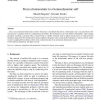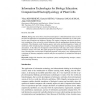179 search results - page 26 / 36 » Membrane Computing |
BIOSYSTEMS
2008
13 years 10 months ago
2008
Life as an autonomous homeostatic system is discussed. A mechanism that drives a homeostatic state to an autonomous selfmoving state is examined with two computational cell models...
BMCBI
2010
13 years 10 months ago
2010
Background: While occurring enzymatically in biological systems, O-linked glycosylation affects protein folding, localization and trafficking, protein solubility, antigenicity, bi...
IIE
2008
13 years 9 months ago
2008
Abstract. Biology has moved from a bench-based discipline to a bioinformational science in modern times but application of computational and analytical methods of informatics in it...
FUIN
2006
13 years 9 months ago
2006
This paper is an attempt to incorporate the idea of spiking neurons into the area of membrane computing, and to this aim we introduce a class of neural-like P systems which we cal...
JUCS
2007
13 years 9 months ago
2007
: Spiking neural P systems are computing models inspired from the way the neurons communicate by means of spikes, electrical impulses of identical shapes. In this note we consider ...


